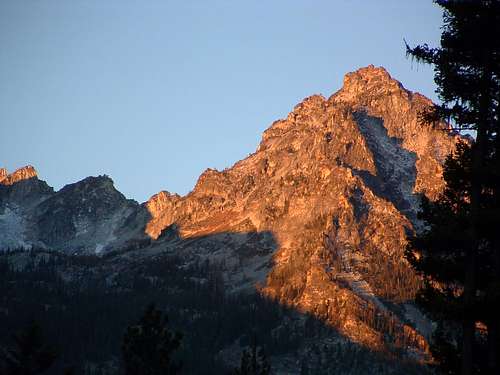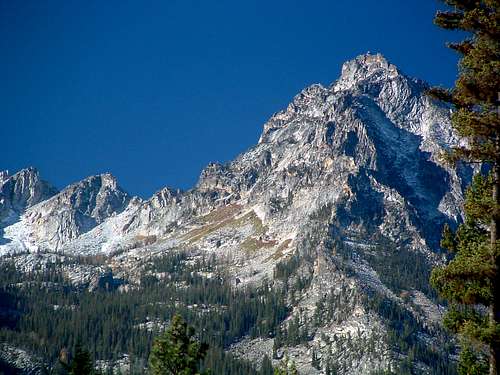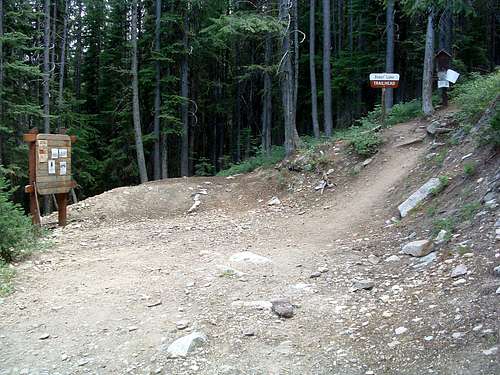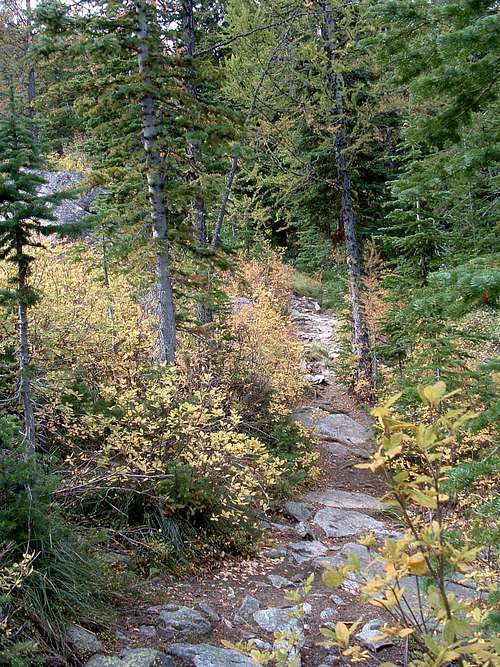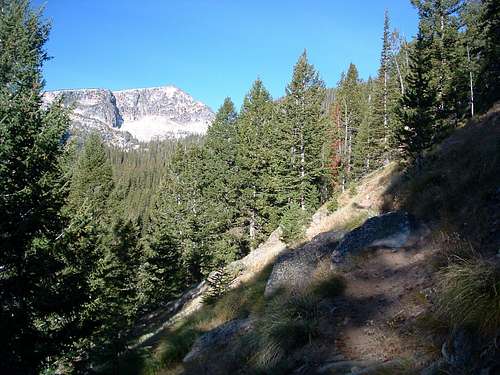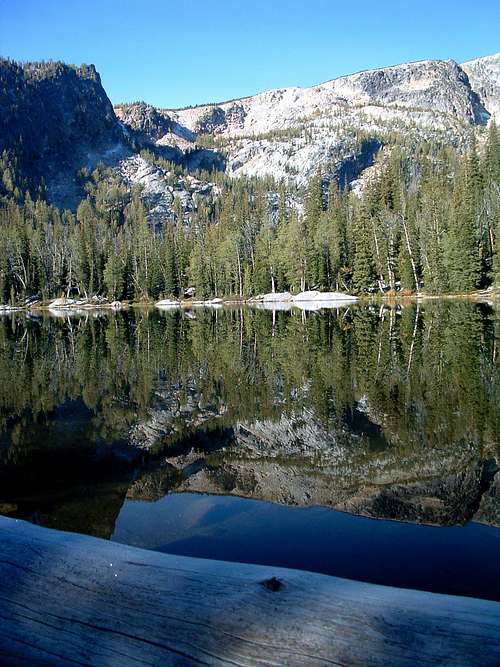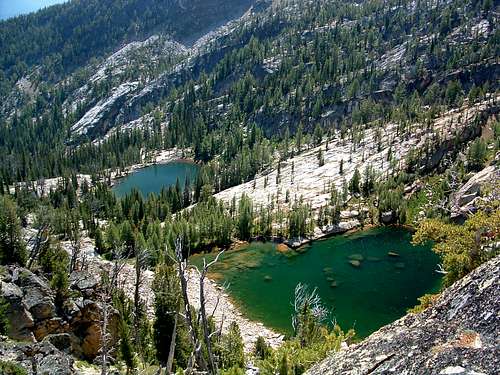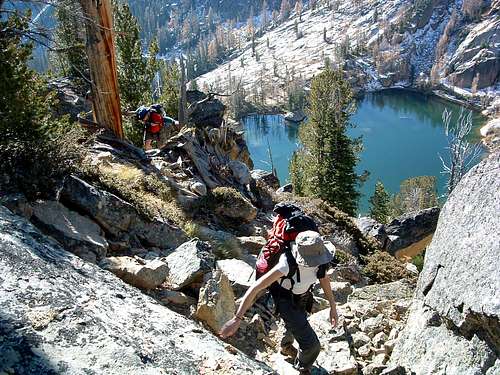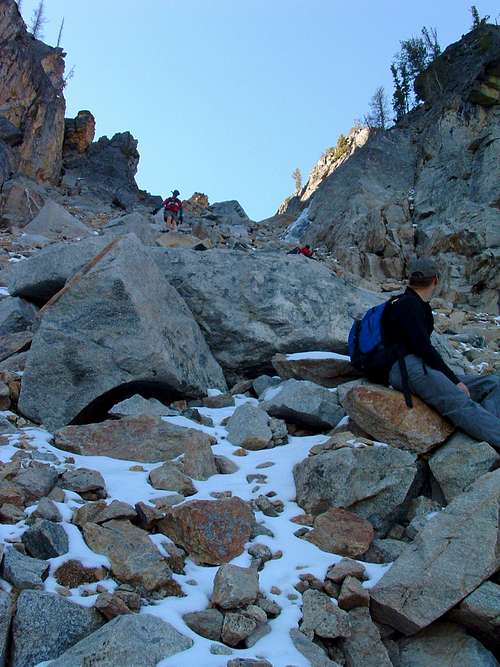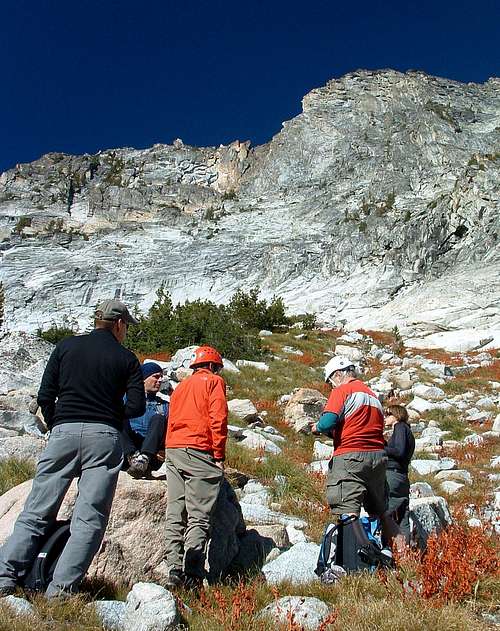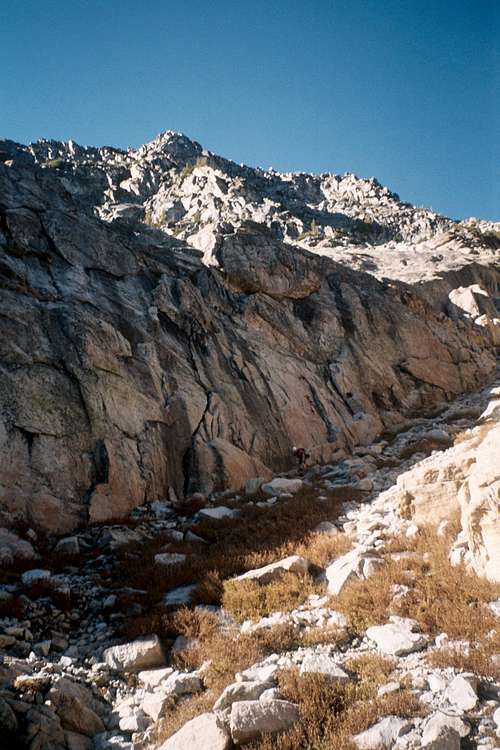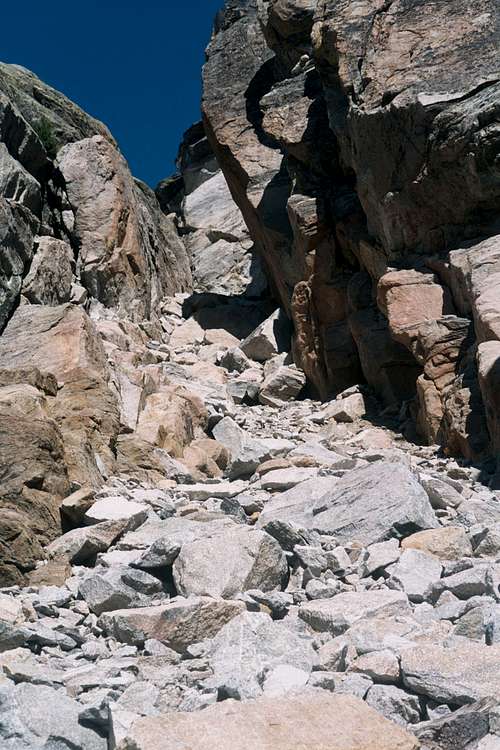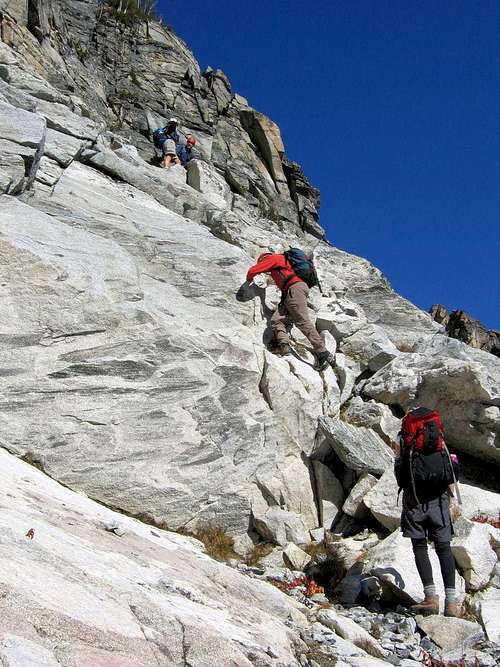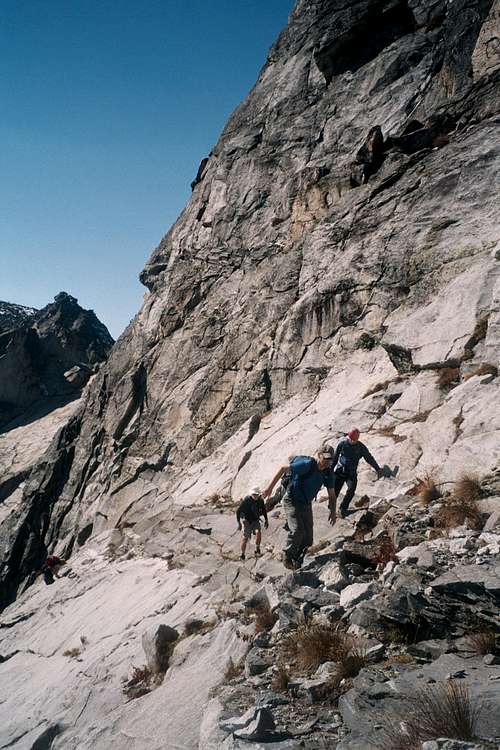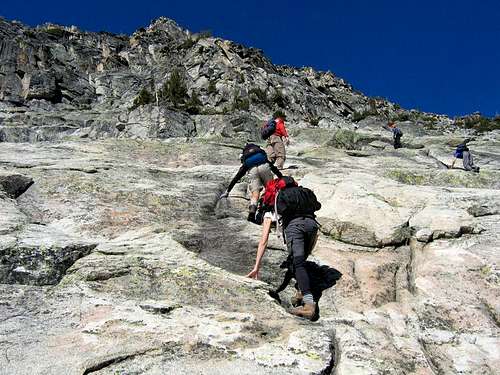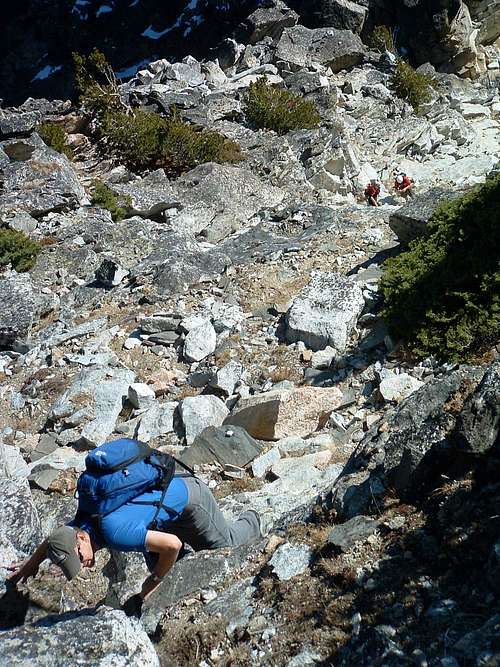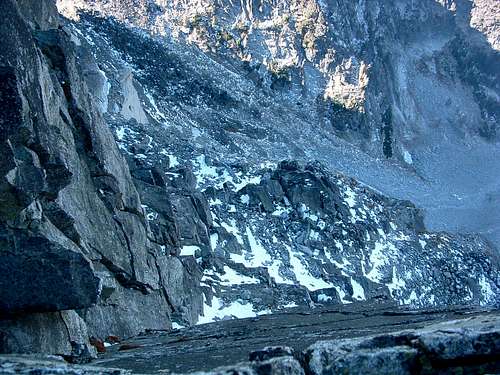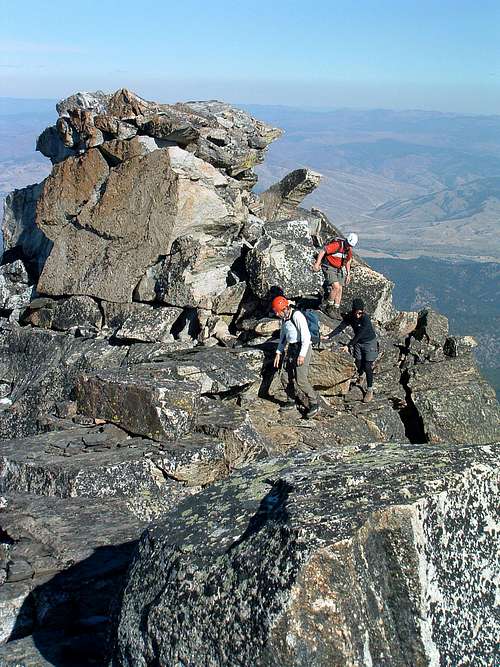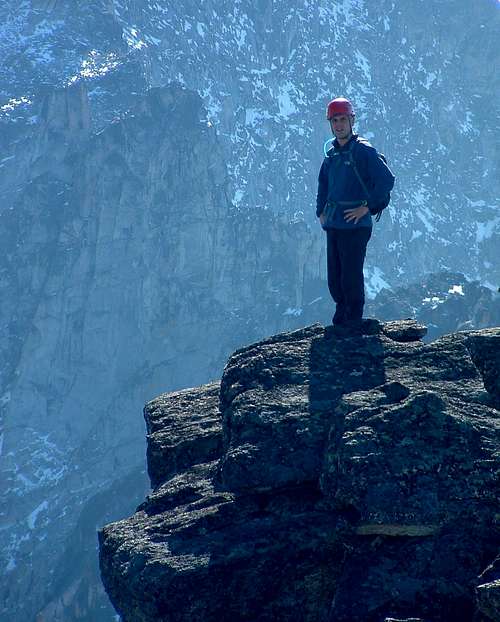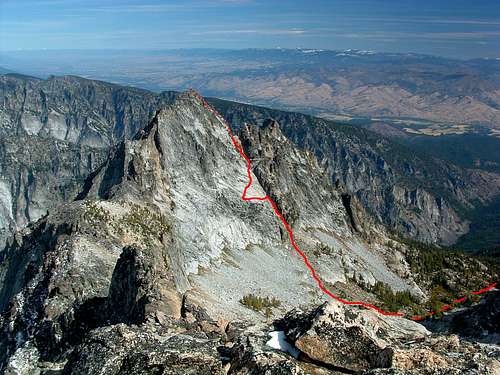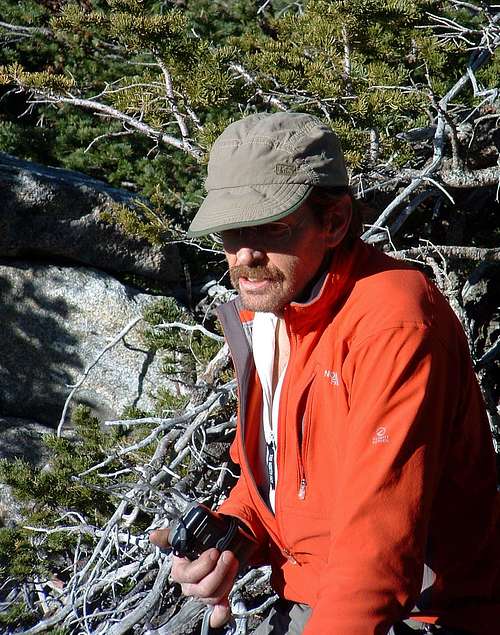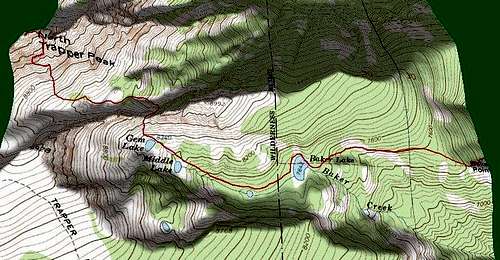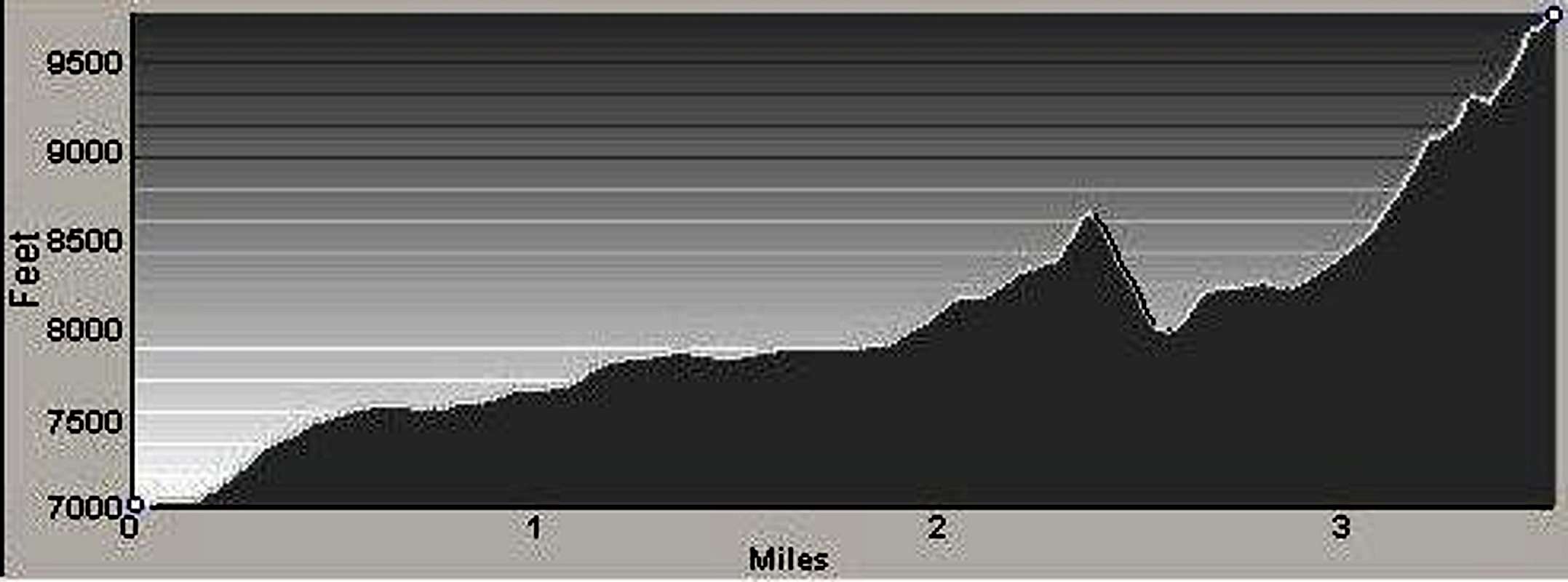-
 14540 Hits
14540 Hits
-
 79.78% Score
79.78% Score
-
 11 Votes
11 Votes
|
|
Route |
|---|---|
|
|
45.90064°N / 114.28955°W |
|
|
Download GPX » View Route on Map |
|
|
Hiking, Mountaineering, Mixed, Scrambling |
|
|
Spring, Summer, Fall, Winter |
|
|
A long day |
|
|
Class 4 |
|
|
Very strenuous |
|
|
II |
|
|
Overview
Route Types – Scramble Class Level – Class 4 Elevation – 9,801’ Gain - 4,378’ Distance - 7.4 miles (round trip) Time Required to Complete This Route – A Long Day
From Hwy 93 south of Darby, indeed, from many places in the Bitterroot Valley, it appears that North Trapper reaches a greater height than Trapper Peak. As untrue as that is, North Trapper is certainly the more rugged looking of the two and from some angles appears to be a tremendous horn of rock. Because of the difficulty of the approaches, its craggy appearance, reputation, and the complexity of route finding associated , few make an attempt at reaching this striking summit. Even fewer succeed. Though there may be a few who disagree, North Trapper is generally considered to be a separate summit from Trapper Peak. It certainly has its own very distinct personality and the climbing skills required to reach its summit are more advanced than those needed to reach the summit of Trapper Peak from the standard Trapper Peak Trailhead. The most used routes by which climbers’ have been known to reach the summit of North Trapper are – the connecting ridge between Trapper and North Trapper, North Trapper’s North Ridge, and a route up the Southeast Face. Of all the known routes to North Trapper’s summit, only the Olbu Southeast Face Route is non-technical in nature (Class 4). However, this route is very exposed in sections and can become technical under adverse conditions (rain, snow, ice,…). Tim Sharp provided me with invaluable information about this route, then carefully read my text for mistakes. Fred Rhoderick and Vernon Garner provided additional proofreading and much-needed editing suggestions. Both Vernon and Tim allowed me to include a few of their pictures, which I must point out, help explain the route much better than my words ever could. A Word About the Route Name: Gerald Olbu and a friend of his pioneered this route back in the 1980's after having been frustrated by the Southeast Couloir several times. He may or may not have been the first human being to summit by this route, but he is most certainly responsible for making it famous. He has led countless Rocky Mountaineers, and then New Rocky Mountaineers (2 local climbing clubs) trips to the summit of North Trapper using this remarkable route. Getting ThereNorth Trapper Peak can be accessed most easily from either of two trailheads, the Baker Lake Trailhead and the Trapper Creek Trailhead. The approach from Baker Lake is used more often because an approach from Trapper Creek entails a substantial increase in both the amount of elevation gain, and off trail hiking required to reach the base of the peak.From Darby, drive south about 4.5 miles on Hwy 93 and turn right (west) onto Montana 473, also known as the West Fork Road. Shortly after mile marker 6, and then passing the Trapper Creek Job Corps, on your right (west), you will see a USFS sign indicating a turnoff for the Trapper Creek Trailhead. Immediately begin looking for the USFS sign to the Baker Lake Trailhead which you should see on the same side of the road in a very short distance (It’s the next right after the Trapper Creek Trailhead turnoff). Turn right (west) onto Pierce Creek Road (FS 363). At 1.1 miles after leaving the West Fork Road, a road cuts off to your left (southwest). You want to continue straight ahead, just as the sign indicates. Another mile along the road, at 2.1 miles, you turn right onto FS 5634 and the trailhead for Baker Lake. This intersection is signed. Follow it to the end, which is 10.1 miles from your turnoff from the West Fork Road.. There is parking space for several cars, but it’s a tight spot for turning around. The trail begins going immediately uphill at the end of the road. Route DescriptionThe Approach - Baker Lake Trailhead to the Base of North Trapper’s Southeast Face Beginning immediately at the trailhead, you enter a steep section of the approach trail, when your legs are nice and fresh. Fortunately, the steepness only lasts about 15 minutes, which is about how long it takes to reach Baker Point, an interesting rock outcropping above a field of talus. Shortly after leaving Baker Point, the trail begins to level off enough to let your legs recover from your early elevation gain. As the route begins a traverse along the north side of one of Trapper Peak’s long ridges, you get your first glimpse of the top portion of East Trapper Peak. (Just as a point on interest - there are no known routes up its massive North Face.) As the trail nears Baker Lake, some nice outcroppings of granite boulders sit uphill and to the right (north) of the trail. Every time I see them I think they would be appealing to those who like bouldering or want to practice climbing techniques on rocks that are comparatively accessible. Just before reaching Baker Lake, the trail splits. The left (and most obvious) fork goes almost directly south as it bypasses the lake, through a boggy area, and connects to the Baker Lake Ridge Route to Trapper Peak. Keep a sharp watch for a couple of cairns marking the right (west) fork up and over some slabs. The right (west) fork is what you want to follow to reach the lake. If you’ve been keeping a good hiking pace, less than 45 minutes after leaving your parked vehicle, you should reach the eastern shore of Baker Lake, about 1.25 miles from the trailhead. Though a trail completely encircles the lake, the best way around is on Baker Lake’s north side (your right). Follow this trail around until just before it reaches the creek flowing from the higher lakes, then turn right (southwest) onto the path leading away from the lake. The track stays on the north side of the creek as it goes uphill toward Middle Lake, close to .75 mile from Baker Lake’s eastern shore. In the past, this section of trail has been spotty and difficult to follow. But over the past few years, as more and more people have made the hike to Gem Lake, the trail has gotten enough use to make its track more obvious than before. Now days, you’re less likely to lose it. As you pass Middle Lake, the trail stays on the north side of the inlet creek flowing from Gem Lake. In less than .25 mile you will reach the northeast corner of Gem Lake, a beautiful little tarn 2.25 miles from the trailhead. Begin the off-trail section of this approach by traversing around the north side of Gem Lake on talus toward the bottom of a not-so-obvious gully (more a slight depression than a deep gully) leading up to the obvious col (saddle) about 290’ above the lake. Pick your own track to ascend. As you climb do your best to avoid the trees, brush, and scree along the way. There is no "perfect" route up, but careful route finding will allow you to conserve some energy and climb over less deadfall. From the col, at about 8,630’, descend the very loose rock and scree in the steep and obvious couloir (gully) down into the bowl between you and North Trapper. There is a lot of loose stuff in this couloir, so it makes sense to don a helmet before beginning your descent. Normally you would exit the couloir (after descending only about 200’) to your left (west) and begin a westerly traverse along slabs and narrow ledges at approximately 8,400’ elevation toward the base of North Trapper’s southeast face; however the day we attempted this route, there was too much snow and ice on the slabs to allow for safe passage. On October 14, 2006, to avoid those slippery slabs, we continued to the bottom of the couloir, at an elevation 8,000’. We then traversed over talus and large granite blocks in a northwesterly direction below a cliff band and along a small stream before turning almost directly west and climbing toward the base of North Trapper through a mixture of brush, whitebark pine, larch, and huge scattered boulders into the upper levels of the cirque. It is at this point (the base of North Trapper’s southeast face) that the two approach routes meet and the climbers’ route begins (the other approach being from Trapper Creek Trailhead). The Climbers’ Route - Base of North Trapper to the Summit Upon reaching the base of the peak, you are greeted with a talus-covered slope from which rises the seemingly impossible granite colossal, North Trapper. (In spite of the fact that the talus is mixed with scree, the slope proves to be surprisingly stable and easy to climb.) Studying the mountain from this position, you can see an obvious couloir leading up toward the East ridge-crest. Climb the talus toward the bottom of the couloir and enter its lower end. There is a bit of loose rock in the throat of the couloir, though not nearly as much as in the couloir you descended into the bowl during the approach. Still, it’s a good idea to wear a helmet. Continue upward until you reach an elevation near 9,000’, then exit the couloir to the left (west) by a low rock ramp onto slabs (there is also a lower ramp with a grassy ledge system, but this only leads to cliffs and should be avoided). Though inclined, these slabs are not so steep as to make climbing on them difficult. In fact, the farther left (west) you go on these slabs (up to a point), the more gentle the slope. Traverse the slabs in a westerly direction, curving slightly until you get close to the more vertical portions of the summit’s face, then scramble up and a bit right (east) to reach a dike (volcanic intrusion) of black rock which slants upward across the face from west to east (left to right). This black dike is a key to the completion of this route (keeps it from being a technical climb), and forms an easy ledge which follows just below the near-vertical southeast face. Continue along the lower edge of the dike for about hundred yards, all the way back to the couloir, but do not reenter. Instead, climb the obvious gully just to the left (southwest) of the couloir on dirt and rock all the way to its top just below the crest of the ridge. At the gully's top, turn slightly left and climb the stable granite blocks to a small notch in the ridge-crest. Before you begin climbing the ridge-crest, take a moment to peer through the notch down the northwest face of the mountain. Beneath you the vertical sheer face of North Trapper falls swiftly away! The view will take your breath away and emphasize the exposure you face while on the ridge-crest and summit. Climb up out of this notch on good edges. You will quickly reach a vertical step, 6 to 7 feet high. This step is the crux of the route and requires a moderate 5.4 move (more details in the Trip Report). Once past the block it is a short scramble to the summit over stable granite blocks. In spots there is a bit of exposure, but nothing extreme (in the presence of high or gusty winds, the exposure along the entire ridge-crest would be very dangerous). There is quite an elaborate register at the summit. Be sure to sign it. Reverse this route for your descent, being especially vigilant of the loose material in the couloirs. It’s much easier to get hurt when you’re tired. And remember, the climb is not over until everyone has returned safely to the trailhead. Essential GearUnder normal circumstances, and good weather, standard hiking gear and a helmet should be all that’s required for this route (a helmet because of the loose rock in the gullies). If this route is attempted when the rock is slick from rain, ice, or snow, then carrying some sort of protection is recommended because of exposure along the route. A further word of caution here; the slabs on the lower face can become flowing rivulets of water in a storm, so it is advisable to be off the peak before any afternoon thunder storms.
The presence of snow in the gullies will necessitate the use of crampons and ice axes and could force parties to rope up. When to GoThis route is most often climbed when it is free of snow, ice, or rain. However, it is viable any time of year if your climbing party has experience and expertise in mountaineering under adverse conditions.If you intend to climb this route during the winter, keep in mind that once it reaches Gem Lake, this route passes through several areas which are susceptible to avalanche. Continuously assess snow conditions and carry a transceiver, shovel, and probe pole, plus know how to use them. Additionally, any serious depth of snow on the access roads will increase the length of the approach by several miles. Route StatisticsThanks to Tim Sharp and Vernon Garner for some of the descriptive photographs used on this page. |


